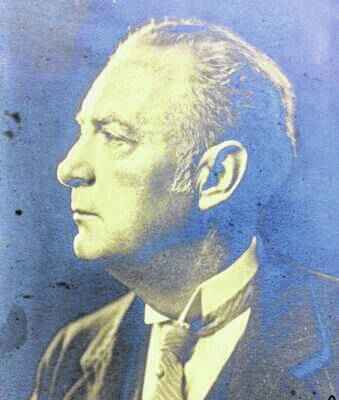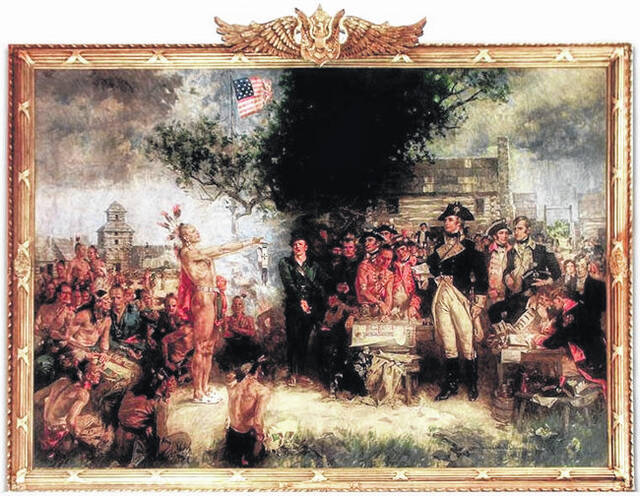

Christy
Provided photo

Christy’s mural painting of the Signing of the Treaty of Greene Ville was unveiled in Greenville in 1945.
Provided photo
Near Darke
By Hank Nuwer
Famous artist and illustrator Howard Christy negotiated a $20,000 contract with the City of Greenville in 1945 to create a mural that commemorated the Signing of the Treaty of Greene Ville.
That payment translates to $309,000 in a 2021 conversion.
Christy, an Ohio farm boy born in Morgan County, became a fixture here in the spring of ’45. He pored over city records, read a history of Fort Greene Ville, and researched the biographies of the signers of the Treaty.
The city unveiled the enormous, detailed mural in a week-long gala sesquicentennial celebration in August 1945.
Germany’s Hitler had been defeated, and Japan’s fall was imminent. Days after the celebration, atomic bombs destroyed Hiroshima and Nagasaki.
People partied like it was 1795. Bunting and flags covered every building downtown.
Long queues formed to gaze upon the actual treaty behind glass.
Guarded by two soldiers, the parchment was yellow and brittle. Nonetheless, the signature of President George Washington and the marks of the Native American signers wowed one and all.
Many men grew beards.
Roy Cable grew chin whiskers and donned a top hat and frock coat to turn himself into a clone of Abraham Lincoln. And never mind that Lincoln, born in 1809, wasn’t even a gleam in his mom’s eyes in 1795.
A covered wagon pulled by two fat oxen led the slowest parade on record.
Women wore bonnets and long prairie dresses as they marched. Men decked out in buckskins and coonskin caps.
A ball followed with musicians playing the minuet. The apparel changed to gowns and frocked coats atop knee-high breeches.
Of course, many dressed like Native Americans, though hopefully none in loin cloths. One man imitated a chief in a stunning headdress and a beaded shirt.
Unfortunately, he ruined the effect wearing bifocals.
On the day of the unveiling, local celebrity Lowell Thomas congratulated Greenville in a spirited amplified broadcast.
Then it was time for oohs as the unveiling moment came.
The painting displayed Little Turtle offering a wampum belt of peace to Maj. Gen. Anthony Wayne.
Looking on during the solemn moment were heroes of history William Henry Harrison, Meriwether Lewis, Blue Jacket and Tarhe, the tall, thin warrior nicknamed The Crane.
One year before the signing, the allied tribes had endured a crushing defeat by Wayne’s militia at the Battle of Fallen Timbers.
Up on the podium on Aug. 3, 1945, with other dignitaries, was artist Howard Chandler Christy.
A reporter described him as ruddy and plump, a “Santa Claus on his summer vacation.”
He was in the twilight of a long career as artist and illustrator.
The artist William Merritt Chase served him as teacher and mentor.
In many ways, Christy was a walking contradiction, and an American legend.
The ministry admired his religious portraits of Jesus and the Virgin. His pinup illustrations of “The Christy Girl,” and his nude paintings, attracted a whole different audience.
Born in 1872, he gained fame in 1898 as a young, dashing illustrator. He shadowed Teddy Roosevelt’s Rough Riders during the defeat of Spain in Cuba.
His portraits and battle scenes graced leading magazines of the time.
He was a bold, chance-taking war correspondent. All the USA in that Yellow Press era knew his name — along with writers Stephen Crane and Richard Harding Davis — the latter notorious for firing at Spanish troops while covering battles.
When America declared war on Germany in 1917, Christy painted a series of patriotic posters.
“If you want to fight, join the Marines!” said a fetching model in a blue military uniform.
So famed was he for capturing beautiful women on canvas that the first Miss America pageant in 1921 appointed him a judge.
There were screams of outrage from competitors when they learned that Margaret Gorman, winner of the Golden Mermaid trophy, had posed for Christy.
You might say the ladies thought that — ahem — sketchy.
More screams came when a contestant was disqualified for — Heavens! — having a husband.
What immortality he has today comes from historic murals but also his stunning portraits of presidents, generals and dictators. His subjects included Theodore and Franklin Delano Roosevelt, Calvin and First Lady Grace Coolidge, Gen. Douglas MacArthur, and the Italian dictator Mussolini.
He even weathered a nasty divorce in 1910 when his wife accused him of some panky with models wearing naught but a hanky.
However, his lawyer countered that madame had been observed roaring drunk with her chauffeur — witnessed by none other than Howard’s parents.
Howard won custody of his daughter. The couple then tried to make a go of the marriage before divorcing for real.
Christy died in 1952 of a heart ailment.
“He was a great artist and native son of Ohio,” said Gov. Frank J. Lausche. “Usually individuals, as they grow older, wane in their abilities … His paintings grew more fascinating as the years went on.”
In his tribute, Lausche pointed to one painting, in particular, out of the artist’s thousands of illustrations and paintings.
That painting was the “Treaty of Greene Ville” now displayed forever at the Ohio Capitol.
Hank Nuwer is an author, columnist and playwright. He and wife Gosia live on the Indiana side of the Union City state line. Viewpoints expressed in the article are the work of the author. The Daily Advocate does not endorse these viewpoints or the independent activities of the author.




